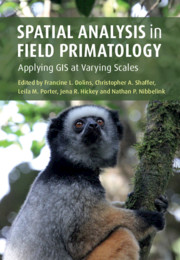Book contents
- Spatial Analysis in Field Primatology
- Spatial Analysis in Field Primatology
- Copyright page
- Dedication
- Contents
- Contributors
- Acknowledgments
- 1 Why Place Matters, and its Use in Primate Behavioral and Ecological Research
- Part I GPS for Primatologists
- Part II GIS Analysis in Fine-Scale Space
- Part III GIS Analysis in Broad-Scale Space
- Introduction
- 15 Modeling Niches and Mapping Distributions
- 16 Does Reduced Habitat Quality or Increased Hunter Access Explain Defaunation of Fragmented Forests?
- 17 Landscape Ecology of Deforestation Processes and Lemur Biogeography in Madagascar
- 18 Quantitative Methods for Primate Biogeography and Macroecology
- 19 GIS and GPS Techniques in an Ethnoprimatological Investigation of St Kitts Green Monkey (Chlorocebus sabaeus) Crop-Foraging Behavior
- 20 Conclusion
- Index
- Plate Section (PDF Only)
Introduction
from Part III - GIS Analysis in Broad-Scale Space
Published online by Cambridge University Press: 29 January 2021
- Spatial Analysis in Field Primatology
- Spatial Analysis in Field Primatology
- Copyright page
- Dedication
- Contents
- Contributors
- Acknowledgments
- 1 Why Place Matters, and its Use in Primate Behavioral and Ecological Research
- Part I GPS for Primatologists
- Part II GIS Analysis in Fine-Scale Space
- Part III GIS Analysis in Broad-Scale Space
- Introduction
- 15 Modeling Niches and Mapping Distributions
- 16 Does Reduced Habitat Quality or Increased Hunter Access Explain Defaunation of Fragmented Forests?
- 17 Landscape Ecology of Deforestation Processes and Lemur Biogeography in Madagascar
- 18 Quantitative Methods for Primate Biogeography and Macroecology
- 19 GIS and GPS Techniques in an Ethnoprimatological Investigation of St Kitts Green Monkey (Chlorocebus sabaeus) Crop-Foraging Behavior
- 20 Conclusion
- Index
- Plate Section (PDF Only)
Summary
Primatologists take it for granted that it is important to study primates. We rarely consider the unique quality of the information that we uncover, because we expect to be intrigued and surprised by what we find; we expect to be able to put together more of the puzzle pieces as well as to identify additional parts of the puzzle. The individual primates we observe and test, and the groups, populations, and species to which they belong, teach us about their day-to-day lives and the distinctive ways they survive, and help us uncover their specific past and the shared past of our common ancestors. Geospatial technology is critical to aiding primatologists in these efforts. Compared to previous technologies (e.g., a Brunton compass, tripod, a 50 m tape measure, onion paper, ruler and a good pencil with an eraser to hand-draw maps and paths), it is much easier, collects more accurate data and allows more accurate analyses using geographic information systems (GIS), and allows greater flexibility in terms of how to effectively implement these data for multiple types of analyses.
- Type
- Chapter
- Information
- Spatial Analysis in Field PrimatologyApplying GIS at Varying Scales, pp. 309 - 314Publisher: Cambridge University PressPrint publication year: 2021

